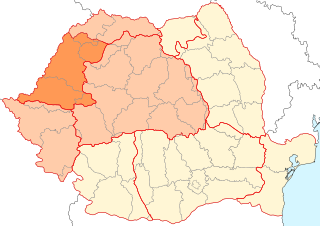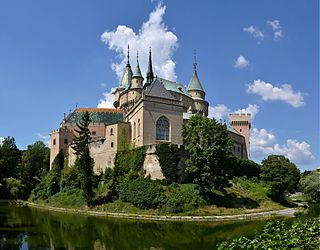
Géza I was King of Hungary from 1074 until his death. He was the eldest son of King Béla I. His baptismal name was Magnus. With German assistance, Géza's cousin Solomon acquired the crown when his father died in 1063, forcing Géza to leave Hungary. Géza returned with Polish reinforcements and signed a treaty with Solomon in early 1064. In the treaty, Géza and his brother Ladislaus acknowledged the rule of Solomon, who granted them their father's former duchy, which encompassed one-third of the Kingdom of Hungary.

Crișana is a geographical and historical region in north-western Romania, named after the Criș (Körös) River and its three tributaries: the Crișul Alb, Crișul Negru, and Crișul Repede. In Romania, the term is sometimes extended to include areas beyond the border, in Hungary; in this interpretation, the region is bounded to the east by the Apuseni Mountains, to the south by the Mureș River, to the north by the Someș River, and to the west by the Tisza River, the Romanian-Hungarian border cutting it in two. However, in Hungary, the area between the Tisza River and the Romanian border is usually known as Tiszántúl.

Coloman the Learned, also the Book-Lover or the Bookish was King of Hungary from 1095 and King of Croatia from 1097 until his death. Because Coloman and his younger brother Álmos were underage when their father Géza I died, their uncle Ladislaus I ascended the throne in 1077. Ladislaus prepared Coloman—who was "half-blind and humpbacked", according to late medieval Hungarian chronicles—for a church career, and Coloman was eventually appointed bishop of Eger or Várad in the early 1090s. The dying King Ladislaus preferred Álmos to Coloman when nominating his heir in early 1095. Coloman fled from Hungary but returned around 19 July 1095 when his uncle died. He was crowned in early 1096; the circumstances of his accession to the throne are unknown. He granted the Hungarian Duchy—one-third of the Kingdom of Hungary—to Álmos.

Álmos was a Hungarian prince, the son of King Géza I of Hungary and brother of King Coloman. He held several governmental posts in the Kingdom of Hungary.

Zlaté Moravce is a town in south-western Slovakia.

Stephen II, King of Hungary and Croatia, ruled from 1116 until 1131. His father, King Coloman, had him crowned as a child, thus denying the crown to his uncle Álmos. In the first year of his reign, Venice occupied Dalmatia and Stephen never restored his rule in that province. His reign was characterized by frequent wars with neighbouring countries.

Saint Bystrík was a martyr and the Bishop of the Diocese of Nitra.

Coloman of Halych was the ruler—from 1214 prince, and from 1215 or 1216 to 1221 king—of Halych, and duke of Slavonia from 1226 to his death. He was the second son of Andrew II of Hungary and Gertrude of Merania. His father and Leszek the White, Duke of Poland, concluded an agreement about the marriage of Coloman and Leszek's daughter, Salomea, and the division of Halych, allotting its western regions to Leszek, the remaining lands to Coloman. The Hungarian and Polish armies occupied the principality in late 1214. Andrew II appointed a Hungarian nobleman, Benedict the Bald, to administer it on Coloman's behalf. Coloman was crowned the first king of Halych with the pope's authorization in early 1216.

Bojnice Castle is a medieval castle in Bojnice, Slovakia. It is a Romanesque castle with some original Gothic and Renaissance elements built in the 12th century. Bojnice Castle is one of the most visited castles in Slovakia, receiving hundreds of thousands of visitors every year and also being a popular filming stage for fantasy and fairy-tale movies. It was owned by Hungarian kings and nobleman from the 12th century until the territory became part of Czechoslovakia after the Treaty of Trianon in 1920 and was acquired by a Czech entrepreneur in 1939.

Tovarníky is a municipality in the Topoľčany District of the Nitra Region, Slovakia. Formerly, it was a part of Topoľčany, later the village became independent.

Čiližská Radvaň is a village and municipality in the Dunajská Streda District in the Trnava Region of south-west Slovakia.

Hont-Pázmány (Hunt-Poznan) was the name of a gens ("clan") in the Kingdom of Hungary. The Gesta Hunnorum et Hungarorum mentions that the ancestors of the family, the brothers Hont (Hunt) and Pázmány (Pazman), originally from the Duchy of Swabia in the Holy Roman Empire, arrived in the late 10th century to the court of Grand Prince Géza of the Magyars:
The next arrivals were Hunt and Pazman, two half-brothers, courageous knights of Swabian origin. These two and their retainers had been journeying through Hungary with the intention of passing over the sea when they were detained by Duke Géza, and finally they girded King Stephen with the sword of knighthood at the river Hron, after the German custom.
Benedict, son of Korlát was a Hungarian nobleman, who served as voivode of Transylvania twice, from 1202 to 1206 and 1208 to 1209. He was styled as "dux" by royal charters – the first one who is not a relative of the royal Árpád dynasty –, which indicated his high social prestige. Due to the lack of sources and the presence of multiple barons named Benedict in the period simultaneously, there are a number of difficulties in drawing and defining his career path.
Sophia was the eldest known child of King Coloman of Hungary and his wife, Felicia of Sicily. She was born between 1097 and 1100. Her son Saul was the heir presumptive to her childless brother, Stephen II of Hungary.
Saul was the heir presumptive of the Kingdom of Hungary from around 1127. He was the son of Sophia, the only sister of Stephen II of Hungary. His childless uncle appointed Saul his heir in 1127. Although Saul survived his uncle, according to a late source, he did not succeed him and died before Béla II of Hungary was crowned king in April 1131.

Ladislaus Garai, also Ladislas Garai, was Palatine of Hungary from 1447 to 1458, and Ban of Macsó between 1431 and 1441 and from 1445 and 1447.
Events during the year 1117 in Italy.
Felician was a Hungarian prelate in the first half of the 12th century, who served as Archbishop of Esztergom from around 1125 until his presumably death in 1139 or later.
Iaroslav Sviatopolkovich, also known as Iaroslav or Yaroslav Sviatopolchich, was Prince of Volhynia from 1100 to 1118.
Paul was a Hungarian prelate in the twelfth century, who served as Archbishop of Kalocsa between around 1111 and 1113.












